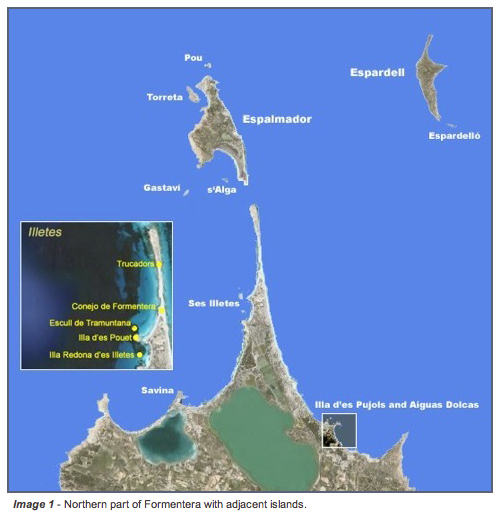|
Introduction
The Ibiza wall lizard, Podarcis pityusensis (Boscá, 1883), endemic to the Pityusic islands (Ibiza, Formentera and 41 adjacent islands) is today devided into 23 subspecies. South to the Es Freus channel, deviding Formentera from Ibiza, there are 8 known populations on islands besides the Formentera population, inhabited by 3 current recognized subspecies; Illa Torreta - Podarcis pityusensis torretensis (Buchholz, 1954), Illa Gastaví - Podarcis pityusensis gastabiensis (Eisentraut, 1928), and Illa d’en Pou, Illa s’Espalmador, Illa s’Espardell, Illa s’Alga, Illa d’es Pouet, Illa Redona de ses Illetes, and Formentera - Podarcis pityusensis formenterae (Eisentraut, 1928). (see: Image 1).
In the past most islands were assigned with their own subspecies, respectively Podarcis pityusensis¬Ý puercosensis (Buchholz, 1954) on Illa d‚Äôen Pou, Podarcis pityusensis espalmadoris (M√ºller, 1928) on Illa s‚ÄôEspalmador and Illa s‚ÄôAlga, Podarcis pityusensis espardellensis (Eisentraut, 1928) on Illa s‚ÄôEspardell, and Podarcis pityusensis algae (Eisentraut, 1928) on Illa d‚Äôes Pouet. In addition there are another 3 discontinued subspecies from nowadays mainland Formentera; Podarcis pityusensis sabinae (Buchholz, 1954) from the former island Savina, today connected to the harbour of Formentera, Podarcis pityusensis grueni (M√ºller, 1928) from the Trucadors peninsula, and Podarcis pityusensis subformenterae (Buchholz, 1954) from the first elevated part of the Trucadors peninsula, just north of Formentera. Both parts of the peninsula are known to be seperated in recent history after flooding, but most of the time this rocky dune system is connected to the main island. Salvador (1984) considered these subspecies as synonym of Podarcis pityusensis formenterae.
Beside the 8 inhabited islands there are 3 rocks which are not investigated in the Ses Illetes group, and 3 islands which are considered uninhabited; Illa s’Espardelló, Illa d’es Pujols (one islet and one rock), and Aiguas Dolcas (two islets and two rocks) (Salvador 1986, 2006).
|

|
|
Variability
Podarcis pityusensis is a very variable species, probably the most variable in lacertid lizards. Not only the number of subspecies (23 today) but also the within subspecies differences are great, and this includes Podarcis pityusensis formenterae.¬Ý To complicate the situation, translocations, both intended as unintended, have been reported (Dierkes 1973, Lilge 1975, Zawadzki 2001). The overall trend seems to be a Podarcis pityusensis pityusensis alike morph from the islands in the north to the more bluish morphs in the south (Cap de Barbaria) and the east (La Mola). An exception are the morphs from Trucadors, formerly assigned to Podarcis pityusensis grueni and Podarcis pityusensis subformenterae, which display a well adapted color pattern to their habitats sandy substrate. (see: Images 2 - 9).
|
|
Es Pujols
One of the main targets of my visit to Formentera, autumn 2009, was to check the uninhabited status of the Pujols islands.
Two islands were checked; Illa de Ses Perreres (Illa d’es Pujols by Salvador 1986, 2006) and Illa d’es Fonoll Mori (one of the Aiguas Dolcas group by Salvador 1986, 2006). (see: Image 10).
The decision not to investigate the other islet, Illa de s‘Aigua Dolca, and the other rocks, was based on the absence of plant cover.
Both investigated islets have a sparse plant cover consisting Crithmum maritimum (Fonoll Mori), Limonium sp., Lotus corniculatus and some heather and grass species. On both islets the covered area is not more then about 800 square meter. The rest of the islets consist of rocks affected by the waves.
My first visit was to Illa d’es Fonoll Mori on a rainy day. It took me a while, but final I was able to find 4 juvenile specimens, which was enough reason to revisit the area on a better day. Two days later, with sunny conditions, and 24º C., I was able to observe on both islets two small populations of circa 10 adult specimens.
They resembled in color the lizards found on the opposite mainland, but they were significantly smaller, like the lizards from Trucadors. This may be due to the less optimal conditions on the islets.
Conclusion
If these two populations were missed by the prior investigators, or originate from a more recent translocation, will remain the question.
|

|
|
Literature
Dierkes, H. (1973) - Als Terrarianer auf dem Pityusen-Archipel - Die Aquarien und Terrarien Zeitschrift, 26: 318-321.
Lilge, D. (1975) - Systematisch-biometrische Untersuchungen an Lacerta pityusensis (Sauria, Lacertidae) - Salamandra, 11: 145-178.
Salvador, A. (1984) - A taxonomic study of the Eivissa wall lizard, Podarcis pityusensis (Bosc√° 1883) - In: Biogeography and Ecology of the Pityusic islands. Monographiae Biologicae. W. Junk, The Hague, 52: 393-427.
Salvador, A. (1986) - Podarcis pityusensis (Bosc√°, 1883) Pityusen-Eidechse - In: Handbuch der Reptilien und Amphibien Europas. Band 2/II Echsen III (Podarcis). Aula verlag, Wiesbaden: 231-253.
Salvador, A.¬Ý (2006) - Lagartija de las Pitiusas - Podarcis pityusensis (Bosc√°, 1883) - In: Enciclopedia Virtual de los Vertebrados Espa√±oles (Museo Nacional de Ciencias Naturales, Madrid): 16p.
Zawadzki, M. (2001) - Verschleppt und ausgesetzt - Neues und Altes zur Eidechsenfauna der Pityusen. √úber die Vermischung einzelner Unterarten und Populationen von Podarcis pityusensis (BOSCA, 1883) - Latrodecta, 2001 (Themenheft 2): 1-20.
www.lacerta.de - Original article - published online: 2010-10-02. Author: MARTEN VAN DEN BERG, Purmerenderweg 141, 1461DH Zuidoostbeemster, The Netherlands, E-Mail: martenvdberg@tiscali.nl
|



